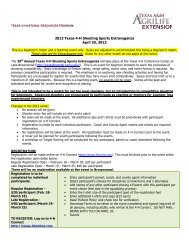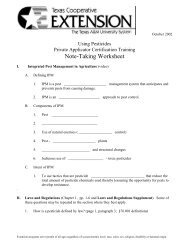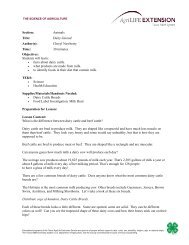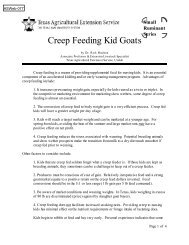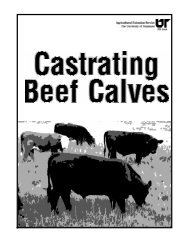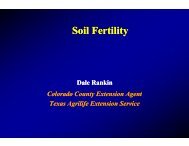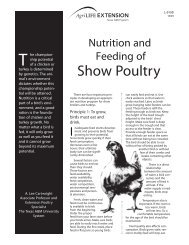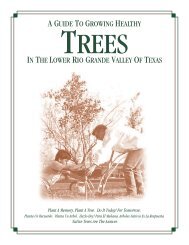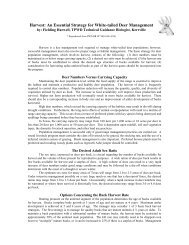Minimizing Losses in Hay Storage and Feeding - MSUcares
Minimizing Losses in Hay Storage and Feeding - MSUcares
Minimizing Losses in Hay Storage and Feeding - MSUcares
- No tags were found...
You also want an ePaper? Increase the reach of your titles
YUMPU automatically turns print PDFs into web optimized ePapers that Google loves.
Table 2. <strong>Losses</strong> of forage quality dur<strong>in</strong>g storage of round-baledgrass <strong>and</strong> grass-legume hay.*___________________________________________________________________________<strong>in</strong> vitro Relative $ valueCrude digestible feed<strong>Hay</strong> type Fraction prote<strong>in</strong> dry matter value loss___________________________________________________________________________- - - % of dry wt. - - - <strong>in</strong>dex $/TGrass unweathered 13.5 58.8 72 —weathered 16.4 42.5 75 9.72Alfalfa unweathered 14.2 56.5 86 —weathered 16.9 34.2 79 22.68____________________________________________________________________________*SOURCE: Lechtenberg, V.L., K.S. Hendrix, D.C. Petritz, <strong>and</strong> S.D. Parsons. 1979. Compositional changes <strong>and</strong> losses<strong>in</strong> large hay bales dur<strong>in</strong>g outside storage. pp. 11-14 In Proc. Purdue Cow-Calf Res. Day. West Lafayette, IN, 5Apr. 1979. Purdue Univ. Agric. Exp. Stn. West Lafayette, IN.1 <strong>Hay</strong> value determ<strong>in</strong>ed: Y = (0.81 x RFV <strong>in</strong>dex) - 14.8 where Y = $/ton of hay. M<strong>in</strong>nesota Quality-Tested<strong>Hay</strong> Auction Data. SOURCE: Mart<strong>in</strong>, N.R., & Duane Schriever. 1996. M<strong>in</strong>nesota forage update Vol. XXI, No. 2, p. 5.usually greater for legumes than forgrasses (Table 2).Some heat<strong>in</strong>g of hay is normal, butextreme heat<strong>in</strong>g (above 120 o F) lowersforage quality along with dry matter.Microbial activity associated withheat<strong>in</strong>g uses soluble carbohydrates,which reduces digestibility <strong>and</strong><strong>in</strong>creases fiber levels. A reduction <strong>in</strong>voluntary <strong>in</strong>take accompanies excessive<strong>in</strong>creases <strong>in</strong> NDF.In addition to caus<strong>in</strong>g huge dry matter losses,weather<strong>in</strong>g lowers forage quality, reduces palatability<strong>and</strong> <strong>in</strong>take, <strong>and</strong> <strong>in</strong>creases feed<strong>in</strong>g losses due toanimal refusal. Cattle ate only the center portion ofthis highly weathered bale.UNDERSTANDING THEWEATHERING PROCESSFrom the preced<strong>in</strong>g discussion, itshould be obvious that most of the haystorage losses which occur are associatedwith hay be<strong>in</strong>g stored outside <strong>in</strong> asituation <strong>in</strong> which it is exposed to theelements, result<strong>in</strong>g <strong>in</strong> weather<strong>in</strong>g. Thelonger hay is exposed to unfavorableweather conditions, the greater losseswill be.How Weather<strong>in</strong>g OccursBales stored outside on the groundwithout covers <strong>in</strong>crease sharply <strong>in</strong>moisture content dur<strong>in</strong>g storage. Thisis especially true for the outer 2 to 3<strong>in</strong>ches of the bale <strong>in</strong> which moisturemay <strong>in</strong>crease by as much as 120%.Weather<strong>in</strong>g beg<strong>in</strong>s slowly, but thenaccelerates because weathered hay ismore easily penetrated by ra<strong>in</strong>, <strong>and</strong>doesn’t dry as rapidly thereafter.In areas of high <strong>and</strong>/or frequentra<strong>in</strong>fall, or with hay which does notshed water readily, the method ofstorage can make the differencebetween less than 5%, or more than50%, dry matter loss from weather<strong>in</strong>g!Furthermore, losses of more than 14%of the total crude prote<strong>in</strong> <strong>and</strong> morethan 25% of the total digestiblenutrients can occur <strong>in</strong> the most highlyweathered portions of a bale. Animportant associated factor is that thepalatability of weathered portions ofbales is decreased, which lowers <strong>in</strong>take<strong>and</strong> <strong>in</strong>creases refusal.Thatch FormationIn theory, a round bale should form athatch that will, at least <strong>in</strong>itially, shedalmost all of the ra<strong>in</strong> which falls on thetop of the bale, but any of severalfactors may prevent this from occurr<strong>in</strong>g.Examples of forage crops whichhave the potential to thatch well whenpackaged <strong>in</strong> a uniform, dense bale aref<strong>in</strong>e-stemmed, leafy, weed-freebermudagrass or tall fescue.<strong>Hay</strong> made from coarse-stemmedforage crops will not thatch well. Thisis due to large stems, hollow stems, orother physical factors which do notallow thatch formation. For example,water can easily penetrate the tops ofbales of many summer annual grasses,thus quickly beg<strong>in</strong>n<strong>in</strong>g the weather<strong>in</strong>gprocess. Coarse-stemmed weeds with<strong>in</strong>hay can also provide an avenue forwater to penetrate bales.Once a wet layer forms, a bale doesnot shed water well <strong>and</strong> moisture levels<strong>in</strong>side the bale are likely to cont<strong>in</strong>ue to<strong>in</strong>crease dur<strong>in</strong>g the storage period. Asthe wet, moldy area on the top of thebale deepens, less <strong>and</strong> less dry<strong>in</strong>goccurs between ra<strong>in</strong>s. Hence, onceweather<strong>in</strong>g gets underway, it usuallyproceeds much faster than with newlybaled hay.Underst<strong>and</strong><strong>in</strong>g the importance ofthatch formation is made easier byconsider<strong>in</strong>g the amount of water whichmust be shed dur<strong>in</strong>g storage. A 6 footlong by 6 foot diameter bale willreceive about 22 gallons of water foreach <strong>in</strong>ch of ra<strong>in</strong>. Therefore, if there4



